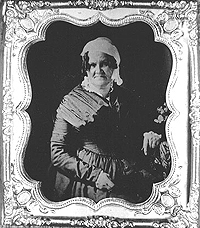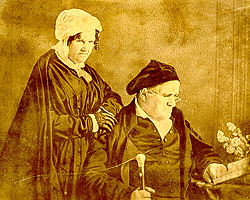
 Introduction
Introduction
 Methodology
Methodology
 Cynthia Barker
Cynthia Barker
 Ruhamah Hayes
Ruhamah Hayes
 Hannah Longbon
Hannah Longbon
 Mary Steinhauer
Mary Steinhauer
 Mary Chase
Mary Chase
 Sophia Chase
Sophia Chase
 Amelia Bloomer
Amelia Bloomer
 Related Links
Related Links
 Credits
Credits
 Home
Home
Sophia Chase
Sophia Chase was born in 1782 to Duncan and Susanna Ingraham of Holland. In 1818, Sophia reunited with Philander Chase, whom she had met in Poughkeepsie while he and first wife, Mary, had lived there. Sophia and Philander married one year later in Worthington, Ohio, where the two made their residence, with Philander and Mary’s two-year-old son, Dudley. Two years later, in 1821, Sophia gave birth to her first child, Henry.
 |
An early photograph of Sophia Chase |
Philander could no longer support his wife and two children on his meager salary, so he accepted a position as president of Cincinnati College, and he and his family moved. They lived in Cincinnati for only two years, and while there, their only daughter, Mary, was born. While the Bishop was raising money in England for his seminary, the family lived with Sophia’s family in Kingston, New York, where she gave birth to a son, Philander, named in memory of her husband’s recently-deceased son.
Bishop Chase had worked to raise money to found Kenyon College in Worthington, Ohio. When the college moved to Gambier in 1828, so did Sophia, Philander, and their children. Sophia opened her home to arriving students and faculty, providing their meals and a place to stay until all buildings were completed. Beyond this, while the Bishop traveled to the South, Sophia was put in charge of Kenyon.
Bishop Chase resigned his presidency at Kenyon College in 1831 and the family moved to a remote, dilapidated cabin near Millersburg, Ohio, a short stay until their move to Gilead, Michigan, where Chase learned of his appointment to the newly-formed Episcopate of Illinois. After collecting enough money, the Chase family moved once more to Grand Prairie, Illinois, where they built their home, the Robin’s Nest. In Grand Prairie, Philander founded Jubilee College, and again, Sophia helped the Bishop in his collegiate duties, and may have even given her husband the idea of the girls’ school at Jubilee.
While in Illinois, Bishop Chase began writing his memoirs, the Reminiscences. Sophia was his editor for the project, which began publication in 1841. The next decade was spent at Jubilee, both Sophia and Philander tending to the College and the Bishop’s publications. In 1852, Philander died after being pulled from his carriage by his horse. Sophia inherited their home and one-third of her husband’s money. She continued to care for children and grandchildren. In 1864, Sophia suffered a stroke and died a few days later on November 15th.
If anyone should ask why my dear wife, who is so essential to my personal comfort, in this my last journey to the east is not going with me, let it be briefly said, because the thing is impossible. The whole college establishment would at this critical period go to ruin if she were to be absent from it this summer. To this necessity she submits with a resignation becoming a saint. She looks up and says "It is thy will, O God." This calms the tempest in her faithful bosom and then all is serene. She is finishing the last garment to make me decent with the least expense for the summer. Would that our churchmen could generally know what this dear mother in Israel has suffered and done to build up the Kingdom of God in the wilderness. She stays at home and works for God. When money is sent for her from those who hear of her devotedness in far countries, she applied it all to pay for the college goods in New York, and when bills accumulate against her husband at home she will not allow even the smallest sums be deducted from them on account of my salary to be allowed her or her husband. Such is the wife of Bishop Chase, and in contemplating her character, who can be unmoved? (Sophia May Chase website)

|
Sophia and her husband, the Bishop |
Sophia Chase devoted her entire life to the happiness of her family. She fell into every assumption of women of the Ohio frontier in the nineteenth century. Though very much in love, she knew that her husband, at the time they found each other, was looking for someone to fill the role of mother to care for his two-year-old son, of housekeeper, and loyal wife. In Sophia, he found all three.
Sophia was stouthearted, as was needed in the Ohio wilderness. Upon arrival at her new abode in the woods of Ohio following her husband’s resignation from Kenyon College, the whole cabin was gutted, filthy, and rotting. Sophia pitied neither herself nor her family, but set to work to make it a home. When her Gilead home burned, she sent sorrowful word to Philander, who was abroad, but she had already begun to make new arrangements for her family. Sophia understood that these were all part of frontier life, and there was no time for sulking. It was her duty to keep her family going under all circumstances.
The wife of a bishop could not help but be especially devout. Philander left the religious education of the children to Sophia whenever business took him from his family, knowing that there was no one more dedicated to their children’s education, nor anyone more devoted to God in both word and deed. Thus, it was simply not in Sophia’s nature to give her time to impure thoughts and certainly not impure actions. Her intense faith both in God and in her husband’s service to God meant that Sophia would never think to defy him, as he was doing God’s work, and any distractions might bear hard on her, her family, and their salvation.
Domesticity was Sophia’s strongest trait. She almost instinctively knew just what to do in any domestic situation. She sheared sheep and spun the wool in order to make clothing for her family; she chopped wood for fences and even sometimes made or mended the fences; she raised her own crops and livestock and prepared each herself from beginning to end; she made clothes from animal pelts (long-lasting and economical); she even made many of the utensils, tools, and cookware necessary for her family’s frontier life.
 |
Philander and Sophia's home in Gambier,
|
Sophia was most challenged at Kenyon College by caring not only for her family, but also the students and faculty of the College. The College was far-removed from almost everything, so the students especially depended on her to meet their needs. While her husband was at home and not away on business, Sophia cooked for the students, did their laundry, tended their illnesses as best she could (she was known for her medical abilities), and cleaned for them. Students even affectionately called the ever-present "Mother Chase."
Sophia distinguished herself from her contemporaries more so than most women with the exceptional role which she played in helping her husband run Kenyon College. When Philander left the College to raise money, he left the day-to-day operations up to Sophia, not trusting anyone else to administer in his stead. She managed its records and accounting, in addition to her other duties.
Gambier March 3d, 1831
My dear Husband,
Yesterday we looked for the return of the carriage in hopes of hearing from you--but think it must have been delayed by high water so that in all probability some days must pass without hearing from you--but I trust you are well and I know you are in God’s holy keeping. A note was received from C Northr[u]p saying he had walked part of the way, found from the rise of the water it would be difficult and expensive getting on. would want two days to see if you thought it worth while to send for him. but thought it better if you could to get along without him. [?]send a letter from a printer from N. Phil--but spoke to Mr Myers this morning to know if he would be wanted. (Mr Bridg[?] is gone) but he think he can get out of the paper with the two boys--Mr Po[?] returned with 2 very fat cattle the one killed weighed 906. and he thinks the other will go over 1000--as they are very fat he thinks he had a pretty good bargain for 60$.00 yesterday he was securing the ice house with [?].--The boys are all well but I Ardin is very ill. The Doctor attends him I believe he is a little better--yesterday I heard of the death of Martin Father of Joe--who lives on the North section--
As I thought you would not wish the 14 newspapers sent mentioned by Mr Galind[e] I have looked them over carefully and find nothing relating to Mr West or Rev Coll[o]nd have cut out all the advertisements that vary in wording--The editorial notice in most cases accompanying them--They come tied up and sealed by Mr Galind[e]s seal so that they had not been opened in N York--The last date is Dec 13th do you not think Mr G-- had some idea all was not well with West--I think he wishes to draw a letter from you--which he will not fail to publish or extracts from it I hope you will be very careful if you write him, as he would wish I suppose, to have you forbid the advertisements that of course makes him your Agent and bills will be presented for payment
I yesterday made a cost on the debts due from [S]tudents up to the close of the term and find it rising $3000 for board and tuition set against this 2000 advance--by a note and from Mr L[?] this morning I find--the debts due from students on the store books amount to $2647_93--so that there is owing from students $3647. and over--I believe you have with you the amount of these store bills--as goods sold the students or Mr L-- Tells me he gave [in] to you the Debts due to [?] from the College--on the Cost book from Sep 15 to March 1
the receipts are $8259
the expenditures 9077As ever yours your affectionate wife
Sophia M Chase